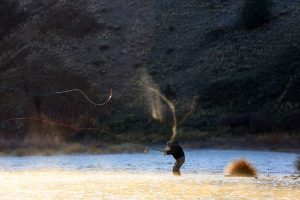Wind can turn an enjoyable fly fishing day into a frustrating challenge, but experienced anglers know how to adapt. Understanding how to adjust techniques and gear when fly fishing in windy conditions ensures continued success. This guide explores essential strategies to combat the wind, enhancing both accuracy and efficiency.
Why Wind Matters
Strong winds affect casting, lure presentation, and line control. Without proper adjustments, even experienced fly fishers struggle with tangled lines or off-target casts. Addressing these challenges starts with understanding wind patterns and adapting techniques accordingly.
Essential Gear Adjustments
- Heavier Lines: Use a heavier line to counteract wind resistance. A weight-forward line offers better control.
- Shorter Leaders: Reduce leader length to improve casting accuracy in windy conditions.
- Wind-Resistant Flies: Opt for smaller, denser patterns that cut through the wind, such as weighted nymphs or streamers.

Casting Techniques for Windy Days
- Sidearm Casting: Keeping the rod lower minimizes wind interference. Sidearm casts stay closer to the water, reducing the chances of the wind catching the line.
- Double Haul Casting: This technique generates more line speed, helping to punch through the wind. Practice the double haul in calm conditions before applying it in the wind.
- Backcast Control: Strong winds can turn backcasts into a tangled mess. Focus on keeping the backcast tight and low.
Positioning and Strategy
- Cast with the Wind: When possible, use the wind to your advantage by casting downwind.
- Adjust Your Stance: Facing sideways to the wind improves balance and reduces the chances of fly lines hitting the body.
- Work the Shoreline: Natural barriers like trees or cliffs can provide wind breaks, creating calmer pockets where fish may gather.
Bait Presentation
Wind affects not only casting but also how the bait appears underwater. Adjust presentations to maintain natural movement:
- Drifting Techniques: Use the wind to create a natural drift.
- Shorter Strikes: Expect fish to be less aggressive in windy conditions, so set the hook quickly with any indication of a bite.
Safety and Comfort Tips
- Wear Eye Protection: Wind increases the chance of a fly whipping back. Polarized glasses offer protection and improve water visibility.
- Stay Aware of Surroundings: Strong gusts can knock anglers off balance, particularly when wading.
Fly fishing on windy days demands adaptability and a strategic approach. By adjusting gear, mastering wind-resistant casting techniques, and understanding wind patterns, anglers can continue to enjoy productive outings. Embrace the challenge, and windy conditions may just become an opportunity for new fly fishing victories.
Image: hatchmag





